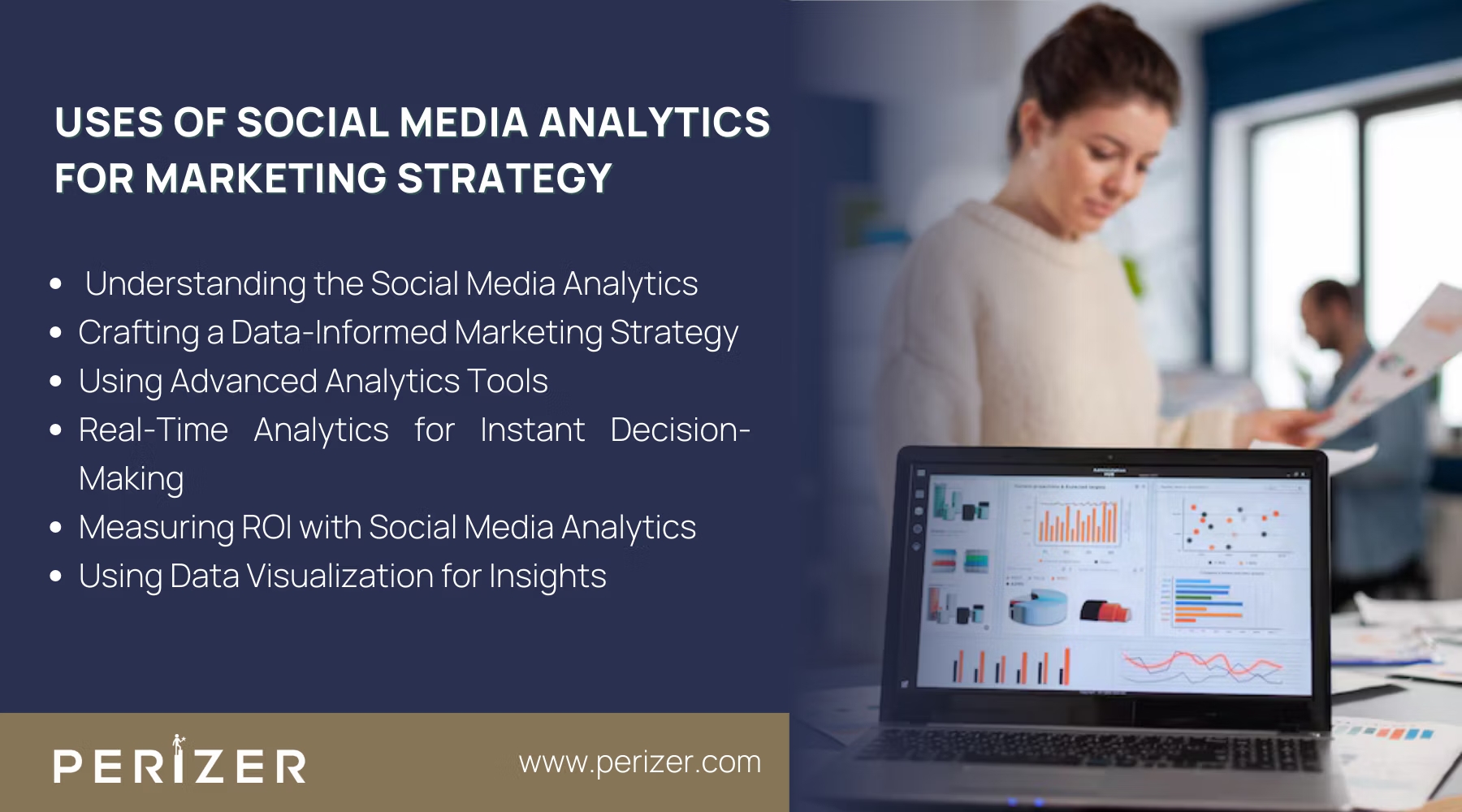How to Use Social Media Analytics for Marketing Strategy
Achieve marketing success with social media analytics. Track metrics, understand audience behavior, and optimize campaigns for maximum ROI

The rapid evolution of social media has turned it into an essential platform for marketers. While many businesses focus on posting content, the real power lies in understanding how that content performs and how your audience interacts with it.
Social media analytics offer a rich source of data, uncovering who your audience is, what they like, and how they engage with your brand. This advanced knowledge allows you to refine your marketing strategies. It ensures your content not only reaches but also relates to your target audience. The key is not just collecting data but interpreting it to inspire meaningful action.
In this guide, we'll share the uses of social media analytics to build a strong marketing strategy, leading to improved engagement, customer loyalty, and business growth.
Uses of Social Media Analytics for Marketing Strategy

1. Understanding the Social Media Analytics
Social media analytics involves analyzing data collected from social media platforms to understand how your audience interacts with your content and to inform your marketing decisions. This includes engagement metrics like likes, comments, shares, and more complex data like audience demographics, conversion rates, and sentiment analysis.
Why It Matters?
Understanding social media analytics helps you identify successful content, areas for improvement, and trends that could affect your strategy. This knowledge allows you to create targeted content that speaks directly to your audience, increasing engagement and conversions.
2. Crafting a Data-Informed Marketing Strategy
Once you've gathered insights from social media analytics, the next step is to craft a data-informed marketing strategy. This involves aligning your marketing goals with the insights you've obtained to create campaigns that resonate with your audience.
1. Defining Objectives
Start by setting clear objectives that align with your business goals. These could range from increasing brand awareness to boosting sales. Ensure your objectives are measurable, enabling you to track progress and adjust as needed.
2. Identifying Key Metrics
Choose metrics that align with your objectives. For instance, if your goal is brand awareness, focus on metrics like reach and impressions. For engagement, track likes, shares, and comments. Align these metrics with your overall marketing strategy to ensure cohesive efforts.
3. Segmenting Your Audience
Use analytics to segment your audience based on demographics, interests, and behaviors. This allows you to customize content to specific groups, increasing the likelihood of engagement. Personalization is key to resonating with your audience and driving conversions.
4. Content Planning
With insights in hand, create content that speaks to your audience's preferences. If data shows that video content is preferred, focus on creating engaging videos. Align content with your brand voice and values for consistency across platforms.
5. Executing Campaigns
Deploy your campaigns across selected platforms, continually monitoring performance to ensure alignment with your objectives. Real-time analytics allow for quick adjustments, maximizing effectiveness and engagement.
6. Optimization
Use data to refine your strategy. If a campaign underperforms, analyze the data to identify areas for improvement and make necessary adjustments. Optimization is an ongoing process that requires regular analysis and adaptation.
3. Using Advanced Analytics Tools
While basic analytics offer valuable insights, advanced provide deeper analysis, helping you refine your marketing strategy further. These tools enable more precise targeting, improved campaign effectiveness, and greater ROI.
Sentiment Analysis
Advanced tools like Brandwatch or NetBase use natural language processing to analyze sentiment around social media mentions. This helps gauge public perception of your brand and products, enabling strategy adjustments to improve brand image.
Predictive Analytics:
Predictive analyticsuse historical data to forecast future trends and behaviors. Understanding potential audience actions allows proactive strategy adjustments, keeping you ahead of the competition.
Competitive Analysis
Tools like SEMrushor BuzzSumo offer insights into competitors' social media activity. By analyzing their successes and failures, you can refine your strategy, gaining a competitive edge.
Influencer Identification:
Identify influencers who align with your brand values and connect with your target audience. Partnering with the right influencers can increase your reach and engagement, boosting brand visibility.
4. Real-Time Analytics for Instant Decision-Making
Real-time analytics provide up-to-the-minute data, allowing you to make informed decisions quickly. This is important in the fast-paced world of social media, where trends can change instantly.
Setting Up Alerts
Tools like Mention or Google Alerts inform you about brand mentions, competitor activities, and industry trends, enabling quick reactions to market changes.
Monitoring Hashtags
Track relevant hashtags to gauge public sentiment and spot emerging trends. This allows you to capitalize on trending topics, boosting visibility and engagement.
Engaging Promptly
Real-time analytics enable prompt responses to customer feedback and inquiries, improving satisfaction and improving brand reputation. Timely engagement builds trust and loyalty with your audience.
Adjusting Campaigns
If engagement drops, analyze real-time data to identify the cause and adjust your strategy accordingly. Quick adjustments ensure campaign success and maximize impact.
5. Measuring ROI with Social Media Analytics
The success of your marketing strategy depends on your ability to measure return on investment (ROI). Social media analytics provide the tools needed to evaluate effectiveness and make informed choices.
Tracking Conversions
Use tracking pixels and UTM parameters to measure social media campaigns' impact on conversions, attributing sales and leads to specific efforts.
Calculating Customer Acquisition Cost (CAC)
Determine the expense of acquiring new customers through social media efforts. Compare Calculating Customer Acquisition Cost (CAC) to customer lifetime value (CLV) for profitability assessment.
Analyzing Engagement Metrics
Evaluate metrics like likes, shares, comments, and click-through rates to understand content resonance with your audience. This insight helps refine future content strategies.
Monitoring Brand Loyalty
Track customer retention and repeat purchase rates to gauge brand loyalty. Loyal customers drive organic growth and act as brand advocates.
Adjusting Budget Allocation:
Identify platforms and campaigns generating the highest ROI and allocate your budget accordingly to maximize returns. Effective resource allocation ensures optimal campaign performance.
6. Using Data Visualization for Insights
Data visualization is a powerful tool for understanding complex data sets and presenting insights in an easily digestible format. Visualizing your social media analytics allows effective communication of findings and informed decision-making.
Choosing the Right Visualization Tool
Tools like or Power BI create visually appealing dashboards and reports. Choose a tool that integrates seamlessly with existing analytics platforms for streamlined processes.
Selecting Key Metrics
Focus on metrics that align with your strategy, using visualizations to highlight trends, patterns, and anomalies. This clarity ensures stakeholders understand insights and make informed decisions.
Creating Interactive Dashboards
Interactive dashboards allow dynamic exploration of data, providing deeper insights into audience behavior and campaign performance. This flexibility improves informed decision-making.
Sharing Insights with Stakeholders
Use visualizations to present findings to team members and stakeholders. Clear visuals make data understandable, facilitating informed strategy adjustments and alignment with business goals.
7. Integrating Social Media Analytics with Overall Business Strategy
To maximize social media efforts, integrate analytics with your overall business strategy. Aligning social media goals with broader business objectives ensures a cohesive approach to growth and success.
Aligning Marketing Goals with Business Objectives
Ensure social media goals support larger aims, such as expanding into new markets or improving customer satisfaction. Cohesive strategies drive business success.
Collaborating with Other Departments
Share social media analytics insights with other departments, informing cross-functional strategies. Collaboration ensures unified efforts toward common goals.
Adapting to Industry Changes
Stay informed about industry trends and changes using social media analytics. Identify opportunities and adjust strategies proactively, maintaining competitiveness.
Measuring Long-Term Impact
Evaluate social media's long-term impact on business growth, tracking metrics like customer lifetime value, brand loyalty, and market share. Long-term measurement ensures alignment with business objectives.
Conclusion
Using social media analytics is important for refining your marketing strategy. By tracking key metrics, you can identify what works and what doesn’t, allowing for informed adjustments. Understanding audience behavior and preferences helps customize your content and campaigns effectively. Regularly analyzing data ensures you stay ahead of trends and competition. Utilizing these insights leads to better resource allocation, higher engagement, and ultimately, a more successful marketing strategy. Use social media analytics to drive continuous improvement and achieve your marketing goals.
FOCUSED, FAST, GOVERNMENT READY
Stay Tuned With Our Latest Insights

Staff Augmentation
Learn how to select the perfect IT outsourcing partner to promote your team’s capabilities, improve productivity, and drRead more...

Staff Augmentation
Find the perfect staff augmentation partner by aligning your goals, evaluating expertise, managing costs, and ensuring aRead more...

Cyber Security
We focus on understanding the needs, behaviors, and expectations of your users through extensive user research. This infRead more...